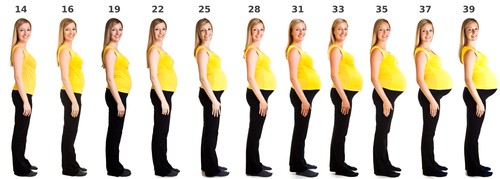
This page presents a detailed overview of human development from the time the sperm is united with the ovum until birth. Prenatal development is divided into three trimesters. During the first two months the developing human is referred to as an embryo. The embryo has three layers from which all body organs develop. During the second trimester the developing human is referred to as a fetus. During the third trimester, the individual is a baby which if born prematurely could survive with extra support. Premature births prior to the third trimester are less likely to survive, even with extraordinary medical care in a neonatal intensive care unit.
First Trimester
First Month
Fertilization, descent of ovum from tube to uterus. Early cell division and formation of embryonic disc from which new organism will develop. Early formation of three layers of cells: (1) the ectoderm, from which sense organs and nervous system will develop (2) the mesoderm, from which circulatory, skeletal and muscular systems will develop (3) the endoderm, from which digestive and some glandular systems will develop. Special layer of cells formed in the uterus which will become the placenta and through which nutritive substances will be carried to the new organism and waste products carried away. Special layer of cells forms the amnion or water-sac, which will surround the developing embryo except at umbilical cord. Heart tube forms and begins to pulsate and force blood to circulate through blood vessels in embryonic disc. Nervous system begins to arise, first in form of neural groove. Development of intestinal tract, lungs, liver and kidneys begins. By end of one month, the embryo is about one-fourth inch long, curled into a crescent, with small nubbins on sides of body indicating incipient arms and legs.
Second Month
Embryo increases in size to about 1½ inches. Bones and muscle begin to round out contours of body. Face and neck develop and begin to give features a human appearance. Forehead very prominent, reflecting precocious development of brain in comparison to rest of body. Limb buds elongate. Muscles and cartilage develop. Sex organs begin to form.
Third Month
Beginning of fetal period. Sexual differentiation continues, with male sexual organs showing more rapid development and the female remaining more neutral. buds for all 20 temporary teeth laid down. Vocal cords appear; digestive system shows activity. Stomach cells begin to secrete fluid; liver pours bile into intestine. Kidneys begin functioning, with urine gradually seeping into amniotic fluid. Other waste products passed through placenta into mother’s blood. Bones and muscles continue development, and by end of third month spontaneous movements of arms, legs, shoulders and fingers are possible.
Second Trimester
Fourth Month
Lower parts of body show relatively accelerated rate, so that head size decreases from one-half to one-fourth of body size. Back straightens, hands and feet are well-formed. Skin appears dark red, owing to coursing of blood showing through thin skin and wrinkles, owing to absence of underlying fat. Finger closure is possible. Reflexes become more active as muscular maturation continues. Fetus begins to stir and so thrust out arms and legs in movements readily perceived by the mother.
Fifth Month
Skin structures begin to attain final form. Sweat and sebaceous glands are formed and function. Skin derivatives also appear — hair, nails on fingers and toes. Bony axis becomes quite straight and much spontaneous activity occurs. Fetus is lean and wrinkled, about one foot long and weighs about one pound.
Sixth Month
Eyelids which have been fused shut since third month, reopen; eyes are completely formed. Taste buds appear on tongue and in mouth and are, in fact, more abundant than in the infant or adult.
Third Trimester
Seventh Month
Organism capable of independent life from this time on. Cerebral hemispheres cover almost the entire brain. Seven-month fetus can emit a variety of specialized responses. Generally is about 15 inches long and weighs about three pounds.
Eighth and Ninth Month
During this time, finishing touches are being put on the various organs and functional capacities. Fat is formed rapidly over the entire body, smoothing out the wrinkled skin and rounding out body contours. Dull red color of skin fades so that a firth pigmentation of skin is usually very slight in all races. Activity is usually great and he can change his position within the somewhat crowded uterus. Periods of activity will alternate with periods of quiescence. Fetal organs step up their activity. Fetal heart rate becomes quite rapid. Digestive organs continue to expel more waste products, leading to the formation of a fetal stool, called the meconium, which is expelled shortly after birth. Violent uterine contractions begin, though milder ones have been tolerated earlier, and the fetus is eventually expelled from the womb into an independent physiological existence.
- Prenatal Development Chart
- Active Birth: The New Approach to Giving Birth Naturally
- A Good Birth, A Safe Birth: choosing and having the childbirth experience you want
- Easing Labor Pain: the complete guide to a more comfortable and rewarding birth
- The Birth Partner: everything you need to know to help a woman through childbirth

